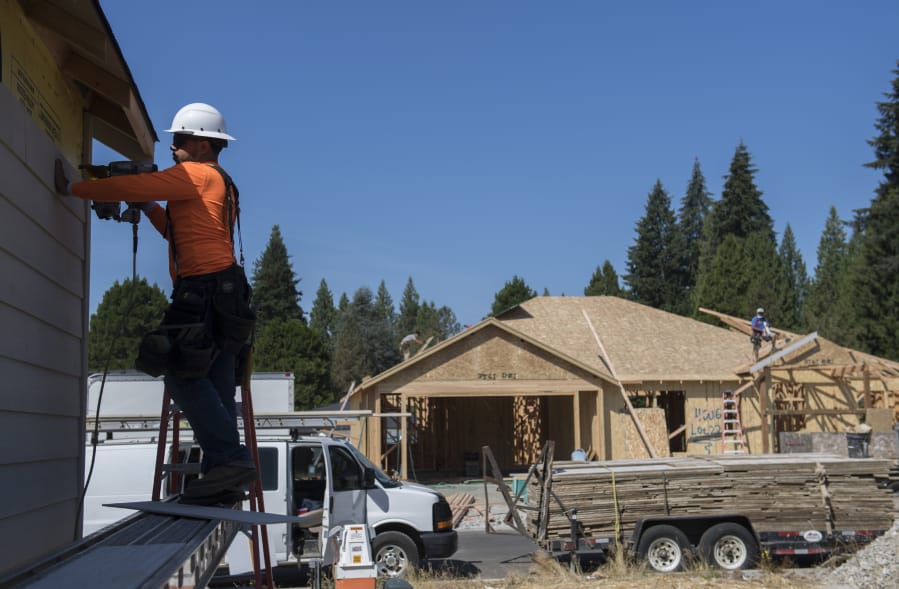Clark County’s housing market has made a rapid recovery from a coronavirus-induced slump back in the spring, and local home developers are confident their upcoming projects will find eager buyers amid the surging demand.
That is, if they can find the materials they need to build them.
Recent weeks have seen local builders scrambling to adjust in the face of widespread shortages of critical components, most prominently lumber and appliances. High demand and low supply have sent prices rocketing upward and increased the time it takes to get supplies delivered.
“I’m hearing numbers that some lumber may be up 30 to 40 percent from the first of the year,” said Jerud Martin, co-owner of Urban NW Homes in Vancouver. “Some truss lumber, they’re talking 60 to 80 percent more than the first of the year.”
Lumber
The National Association of Home Builders reported in an Aug. 6 post on its blog that lumber prices had risen 80 percent since April. In an earlier post in July, the organization said the change was driven by a number of factors stemming directly or indirectly from the COVID-19 pandemic.
Stay-at-home orders in multiple states prompted many lumber mills to suspend operations during the spring, the association wrote, and those that remained open scaled back their operations due to what they expected would be a big drop in demand compared with a usual summer season.
Instead, housing markets have rebounded and home renovation and DIY projects have soared, creating a spike in demand for lumber among developers and at big box retailers. Clark County contractors have been hit with an influx of project requests in recent months, and the July housing market saw year-over-year gains in both new listings and closed sales.
“Conventional logic would say that people would kind of pull back and just watch this, maybe delay some of those decisions, but quite the opposite has been happening,” said Tracy Doriot, owner of Vancouver-based Doriot construction and vice president of the Building Industry Association of Washington.
The higher pricing on truss lumber in particular is likely due to the required wood quality, Martin said — only some mills can process the grade of wood needed to manufacture truss lumber.
Appliances
Local builders say they’ve also begun to encounter serious difficulty securing new appliances, including ovens, dishwashers and light fixtures. Unlike lumber, the problem isn’t necessarily one of rising prices, according to Patrick Ginn, CEO of Vancouver-based homebuilder Ginn Group. The requested appliances just aren’t available.
Michael Shanaberger, director of sales at Vancouver-based Romano Construction Services, said his company began encountering shortages about six weeks ago, and has sometimes had to close home sales and then come back later to finish adding specific things like air conditioning units.
Multiple builders reported having to switch out their usual appliance brands to finish projects on time. The shortages so far have mostly been specific to certain brands, Martin said, but the problem could spread as more builders start placing orders from the brands that still have stock available.
Much like with lumber, the pandemic reduced supply via a wave of disruption at manufacturing facilities — and with so many appliances built overseas, there’s an added disruption from a pandemic-induced slowdown of global shipping.
“The whole import supply chain has been kind of hamstrung by all this,” Doriot said.
Some of the appliance shortages predate the pandemic, Martin said, because they have more to do with import tariffs and the trade war with China. Lighting is the biggest example, he said — certain brands and styles of light fixtures from China have been unavailable for a while. But he and several other builders all agreed that the overall appliance shortage has gotten markedly worse in the past few weeks.
Project costs
Builders can try to account for the pricing and delays by placing orders sooner or switching to substitute products, Ginn said, but many of the shortages are cropping up too fast and not appearing until after developers have already begun work on a project with a set budget and time frame.
“Usually you learn the hard way, because it delays the project,” Ginn said.
Lumber is a significant chunk of the overall build cost for houses. Project budgets typically include some contingencies for material price fluctuations, Doriot said, but nothing that can absorb a potential five-figure added cost if the price of lumber nearly doubles.
Existing projects won’t pencil out unless builders find a way to pass the costs on to buyers, Doriot said — but buyers aren’t all equipped to absorb those costs, either, particularly if they’re financing the house through a bank loan.
“Once you lock these things in, that’s all the money you’re getting,” he said. “These things have the potential to be deal-killers. At the point where the homeowner can’t absorb it anymore, the job can go away.”
Doriot Construction has a niche building higher-end custom homes, Doriot said, giving the company more flexibility to work with clients and make adjustments on a case-by-case basis. And at the other end of the spectrum, Martin said, the big regional and national builders may have more leverage to lock in material prices due to their larger wholesale orders.
It’s the medium-sized local organizations that may end up getting hit the hardest, Martin said, particularly production home builders. The biggest challenge is to keep building homes at the price and pace spelled out in existing contracts, he said — contracts that are based on market conditions from long before the pandemic began.
“A year ago, we had no idea what challenges we were going to be faced with today,” Martin said.
Other materials
Lumber and appliances are the biggest examples, but according to local developers, just about every material cost has gone up to some degree in recent months, and some of the shortages have the potential to impact the commercial development sector too.
Kevin Tapani, vice president at Battle Ground-based Tapani Inc., said there are shortages and longer delivery times for ductile waterline pipe and retaining wall products.
Dean Maldonado, owner of Vancouver-based FDM Development — the company building the Discovery Ridge development in Ridgefield — ran through a list that included structural materials like steel and masonry as well as more specific pieces like streetlights and fence gates.
“Just across the board,” he said. “Every time we turn around, block is up, concrete is up, dirt is up, gravel is up.”
Material pricing and shortages are just one piece of several pandemic impacts on commercial projects, he added. There have also been increased wait times for permit approval and a massive labor shortage that makes it difficult to line up subcontractors, along with more hesitancy from investors and partners due to the uncertainty of the pandemic.
If there’s a light at the end of the tunnel, it may be several months further down the road. The building market typically slows down in the winter, Martin said, so that’s when the lumber mills may finally be able to catch up, and suppliers will have more of an opportunity to warehouse materials in preparation for the coming year.
Ginn offered a similar assessment of the timing.
“Demand is so strong, it just feels like nobody is able to catch up,” he said. “So I just think this summer is going to be a summer of shortages.”




